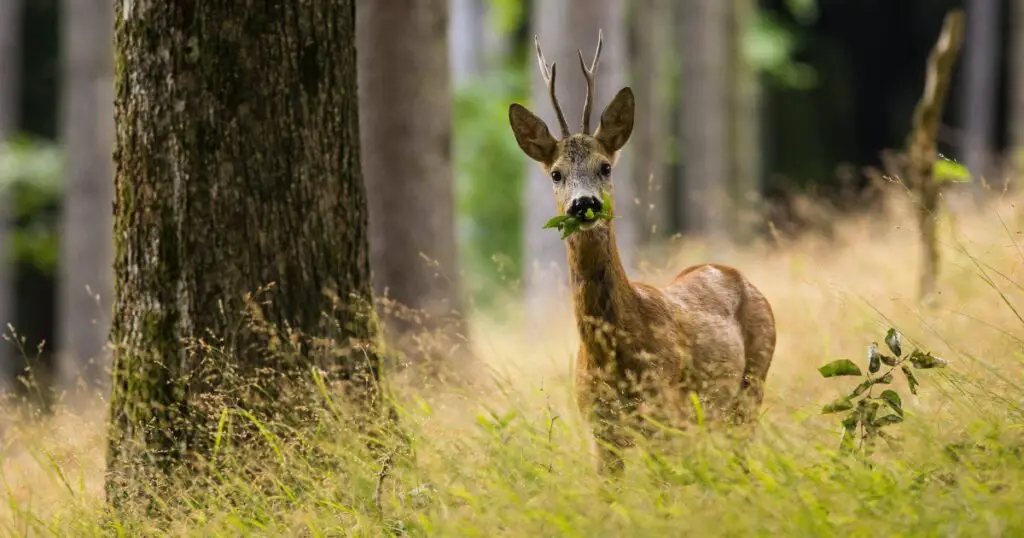There have been some odd stories circulating lately of deer munching on meat. If you’ve come across them (or if you’re just curious about what deer eat) you may ask “Are deer herbivores?” In today’s article we’ll explain that while deer are herbivores, it seems that they (and other kinds of herbivores) will sometimes inexplicably eat meat. Let’s explore why and learn about the dietary preferences of deer.
Are Deer Herbivores? [Answered]
Notwithstanding strange behavior here and there, the answer is yes: deer are herbivores. That means they eat different kinds of vegetation, including grass, leaves and stems from woody plants, berries, nuts, and more. Deer are ruminants, meaning they have a complex digestive system capable of digesting a fibrous diet of mostly plants.
Why do Deer Sometimes Eat Meat?
After reports of deer consuming meat and other products in National Geographic and elsewhere, many people had questions about the diet of deer.
At this point, no one knows why this is the case. Deer are certainly not the only animal to eat things they’re not supposed to, and there may be a deficiency in their diet which leads them to seek out other nutrient sources or to try to consume meat found in the forest.
What Do Wild Deer Eat?
Wild deer are herbivores, and they therefore eat plants. A wild deer will eat foods such as young shoots, berries, twigs, grass, and bark.
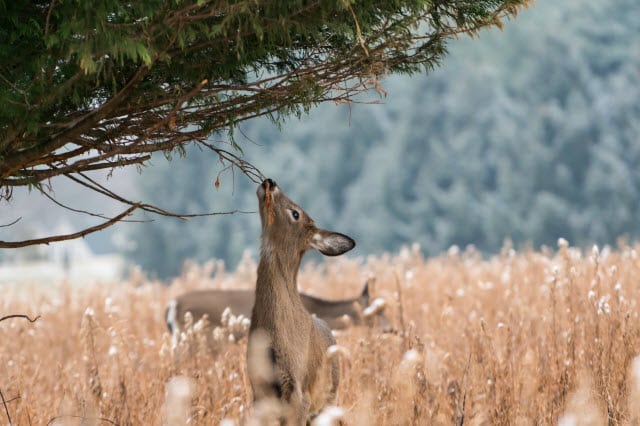
How much a deer eats will depend on its weight.
How Much do Deer Eat Per Day?
A deer will usually eat approximately two pounds of dry food daily for every 100 pounds of its weight. A lactating doe will eat more than this to meet the nutritional needs of herself and of her fawns.
Deer Teeth and How They Chew
As a bovid, deer don’t have upper incisor teeth. In their place, they have a dental pad positioned on the upper mandible.
When the deer needs to grind food, it will grip it between this plate and the lower incisors. Deer are able to eat such hard food (such as twigs) without destroying their teeth because of incredibly strong dental enamel.
What is a Ruminant?
A deer is a ruminant. This means that it brings up their food again after it has been partially digested. They then chew it again (this is called chewing cud). The ruminant digestive system can break down tough materials such as grass, which are high in cellulose.
What Do Captive Deer Eat?
Deer that are kept in captivity are primarily fed hay.
It’s common for captive deer to be fed too much grain because the zookeepers or farm managers treat them like other ruminant species that are domesticated, like sheep. Most deer species don’t require grain in their diets.
In fact, their digestive system isn’t equipped to deal with grains that are highly fermentable. If they eat too much of this, they can end up with a potentially lethal condition called enterotoxemia.
What Do Whitetail Deer Eat?
Whitetail deer eat a variety of foods available to browse on in their native habitat. This includes twigs and leaves, weeds (also known as forbs), nuts, grasses, mushrooms, and fruits. The foods that make up most of a whitetail deer’s diet depends on what is available in a specific time of year.
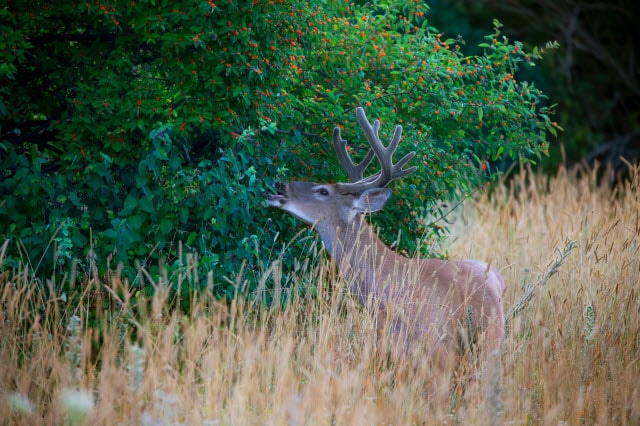
Forbs (weeds) are usually a favorite food of whitetail deer. These weeds are full of nutrients that deer need, and they are especially easy for the animal to digest.
However, these weeds aren’t around for much of the year. After all, long dry periods and the winter can stop their growth.
Browse plants include young trees and shrubs that the deer can reach. There will be browse plants available in some form every time of the year.
While it’s true that these plants will lose all their leaves for the winter, there will still be the twigs and stems for deer to eat and since deer are herbivores, they’ll enjoy these.
The Importance of Mast in Deer Diet
Another food for whitetail deer is mast (fruits, nuts, and acorns). Mast foods are an outstanding energy source, especially when deer are experiencing antler growth or fast body growth.
When a male deer is going through antler growth, he will gravitate to foods such as plums, mulberries, blackberries, and grapes. In the fall when deer are getting fat for winter, they enjoy fruits such as pears and apples.
The two types of nut most significant in the whitetail deer’s diet are chestnuts and acorns. Each of these foods satisfies a specific nutritional requirement. Acorns are excellent sources of carbohydrates and fat.
They don’t have much protein, though. Chestnuts, on the other hand, are protein-rich and high in carboyhydrates. Deer tend to go for chestnuts over acorns, as chestnuts have lower tannin levels. Tannins can cause digestion problems for deer.
Why Deer Don’t Prioritize Eating Grass
While whitetail deer will eat grass, it’s usually not one of their favorite food items. The only exception is when the plant is still early stages of growth.
This is because grass shoots are easier to digest. Whitetail deer love cereal grains, such as rye, wheat, and oats. Whitetail deer also enjoy eating mushrooms. Mushrooms are excellent sources of phosphorus and protein.
Forbs become an especially important part of the whitetail deer diet in the early spring. This is when they are trying to regain all the weight they lost during the fall (the time of the rut), as well as in the winter. Forbs are easy for deer to digest and are rich in important minerals, antioxidants, and energy.
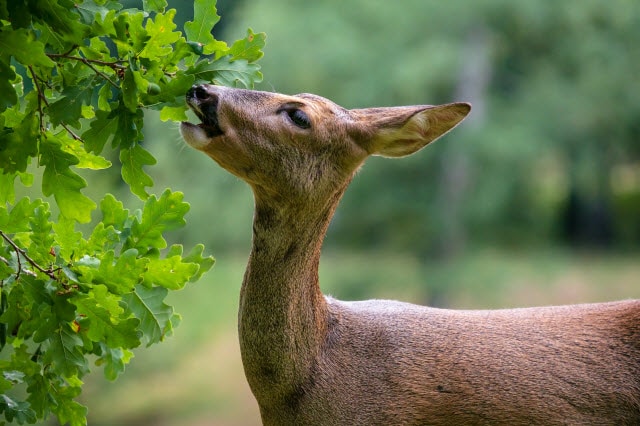
After the start of summer, whitetail deer spend a lot of time eating browse plants. In the middle of the summer to the late summer, the animals gravitate more to berries, grapes, and other early fruits. Whitetail deer will also start looking for foods rich in carbohydrates to get ready for the fall. Examples include pears, apples, chestnuts, and acorns.
What Do Swamp Deer Eat?
Deer living in swamps can be more difficult to find. Of course, as they are living in a different kind of environment than deer living in grassland areas around agriculture, they need to eat different foods.
Sometimes deer will live in a marshy area for the entire year. But it is often the case that deer have made their way to the swamp to get away from hunters in the fall. When deer live in areas with human agriculture, they depend somewhat on crops and the areas around them.
When they live in a swamp, however, they rely more on nuts from many different oak species, as well as green browse. The important part acorns play in the diets of swamp deer means that the animals can usually be found relatively near acorn trees.
What Do Mule Deer Eat?
Mule deer are a larger type of deer that live in more remote areas. While whitetail deer do well in many different kinds of environments and prefer living near human agriculture and habitations, mule deer are different and need to be in the true wilderness.
A mule deer will have a much larger home range than a whitetail. One reason for this is the fact that mule deer need more space to find all the food that they need to survive.
Mule deer living in the Rocky Mountains tend to spend their summers at high elevation, in alpine habitats. That is where they tend to find the most food.
When they have to deal with high snow drifts during the winter, mule deer will tend to travel downhill where they can more easily find food in low-elevation sagebrush habitats.
Mule deer are similar to whitetail deer in that they are mainly browsers instead of grazers. An example of a grazer is elk. As deer are mainly browsers, they prefer shrubs and forbs instead of grass.
As mentioned earlier, though, they do like young grass shoots in the spring. In the winter, mule deer will gravitate to aspen shoots, mahogany, and sagebrush for food sources.
What are Ruminants?
As mentioned earlier, deer are ruminants. This means that food they eat will come back up again from the rumen, which is the first part of the animal’s stomach. When it is brought up, the deer chews it again.
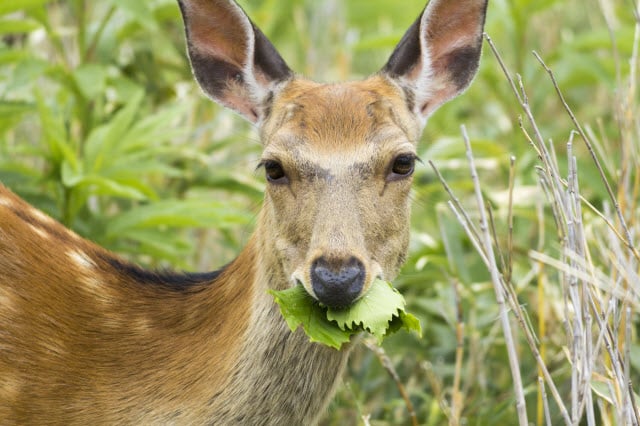
A deer’s gut microorganisms are the most important element of deer digestion. In fact, this animal cannot digest food without them.
In fact, if a deer ever goes without food so long that their good microorganisms completely starve, there will need to be a replacement of the gut flora.
A deer’s stomach has four sections. The rumen is the first section. This is where food goes after the deer chews and swallows it. The food in the rumen later travels back up into the deer’s mouth to be re-chewed before being swallowed again and making its way through the other stomach compartments.
Can Deer Digest Grains Effectively?
Deer have a specialized digestive system that is not well-suited for processing grains. This distinction sets them apart from other ruminants. Consuming excessive grains can lead to enterotoxemia, a potentially fatal condition in deer.
What Role Do Microorganisms Play in Deer Digestion?
Gut microorganisms are indispensable in the digestive process of deer. These organisms are vital for breaking down food. If a deer experiences a prolonged period without food, leading to the depletion of these microorganisms, reintroducing gut flora is essential for the deer’s digestive health.
How Do Deer Chew Without Upper Incisors?
Despite lacking upper incisor teeth, deer have evolved an effective method for chewing. They use a dental pad on their upper mandible, combined with their lower incisors, to grind food. This unique dental structure, along with strong dental enamel, allows them to consume hard foods like twigs without damaging their teeth.
Why Are Mast Foods Important in a Deer’s Diet?
Mast foods, including fruits, nuts, and acorns, are crucial for deer, providing a significant energy source. These foods are particularly important for deer during periods of antler growth and in preparation for winter when they need to build up fat reserves.
Do Deer Prefer Eating Grass?
Grass is not typically the food of choice for deer, except when it is in the early stages of growth. Young grass shoots are easier for deer to digest. Generally, deer have a diverse diet that includes forbs, twigs, leaves, and fruits, rather than focusing primarily on grass.
How Does a Deer’s Diet Change with Its Habitat?
The diet of deer varies according to their habitat. In alpine regions, deer have access to a wide range of food during summer. In contrast, in low-elevation sagebrush habitats during winter, they primarily feed on aspen shoots, mahogany, and sagebrush.
What Is the Difference Between the Diets of Mule Deer and Whitetail Deer?
Mule deer, which live in more remote areas and require larger ranges, have dietary habits similar to those of whitetail deer but with adaptations to their specific habitats. Both species are mainly browsers and prefer shrubs and forbs to grass.
What Are the Nutritional Needs of Lactating Does?
Lactating does have higher nutritional demands to support both themselves and their fawns. Their diet includes a wide range of vegetation to ensure they get sufficient energy and nutrients.

